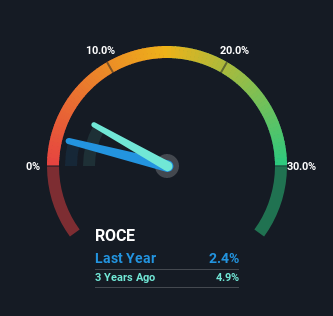- India
- /
- Basic Materials
- /
- NSEI:SANGHIIND
Sanghi Industries (NSE:SANGHIIND) May Have Issues Allocating Its Capital
Did you know there are some financial metrics that can provide clues of a potential multi-bagger? Firstly, we'll want to see a proven return on capital employed (ROCE) that is increasing, and secondly, an expanding base of capital employed. Basically this means that a company has profitable initiatives that it can continue to reinvest in, which is a trait of a compounding machine. Although, when we looked at Sanghi Industries (NSE:SANGHIIND), it didn't seem to tick all of these boxes.
Understanding Return On Capital Employed (ROCE)
Just to clarify if you're unsure, ROCE is a metric for evaluating how much pre-tax income (in percentage terms) a company earns on the capital invested in its business. To calculate this metric for Sanghi Industries, this is the formula:
Return on Capital Employed = Earnings Before Interest and Tax (EBIT) ÷ (Total Assets - Current Liabilities)
0.024 = ₹719m ÷ (₹38b - ₹7.9b) (Based on the trailing twelve months to June 2022).
Thus, Sanghi Industries has an ROCE of 2.4%. In absolute terms, that's a low return and it also under-performs the Basic Materials industry average of 10%.
Check out the opportunities and risks within the IN Basic Materials industry.

Historical performance is a great place to start when researching a stock so above you can see the gauge for Sanghi Industries' ROCE against it's prior returns. If you're interested in investigating Sanghi Industries' past further, check out this free graph of past earnings, revenue and cash flow.
How Are Returns Trending?
When we looked at the ROCE trend at Sanghi Industries, we didn't gain much confidence. Over the last five years, returns on capital have decreased to 2.4% from 7.3% five years ago. Although, given both revenue and the amount of assets employed in the business have increased, it could suggest the company is investing in growth, and the extra capital has led to a short-term reduction in ROCE. And if the increased capital generates additional returns, the business, and thus shareholders, will benefit in the long run.
What We Can Learn From Sanghi Industries' ROCE
In summary, despite lower returns in the short term, we're encouraged to see that Sanghi Industries is reinvesting for growth and has higher sales as a result. And there could be an opportunity here if other metrics look good too, because the stock has declined 57% in the last five years. As a result, we'd recommend researching this stock further to uncover what other fundamentals of the business can show us.
On a separate note, we've found 3 warning signs for Sanghi Industries you'll probably want to know about.
While Sanghi Industries isn't earning the highest return, check out this free list of companies that are earning high returns on equity with solid balance sheets.
New: Manage All Your Stock Portfolios in One Place
We've created the ultimate portfolio companion for stock investors, and it's free.
• Connect an unlimited number of Portfolios and see your total in one currency
• Be alerted to new Warning Signs or Risks via email or mobile
• Track the Fair Value of your stocks
Have feedback on this article? Concerned about the content? Get in touch with us directly. Alternatively, email editorial-team (at) simplywallst.com.
This article by Simply Wall St is general in nature. We provide commentary based on historical data and analyst forecasts only using an unbiased methodology and our articles are not intended to be financial advice. It does not constitute a recommendation to buy or sell any stock, and does not take account of your objectives, or your financial situation. We aim to bring you long-term focused analysis driven by fundamental data. Note that our analysis may not factor in the latest price-sensitive company announcements or qualitative material. Simply Wall St has no position in any stocks mentioned.
About NSEI:SANGHIIND
Fair value with imperfect balance sheet.
Similar Companies
Market Insights
Community Narratives




